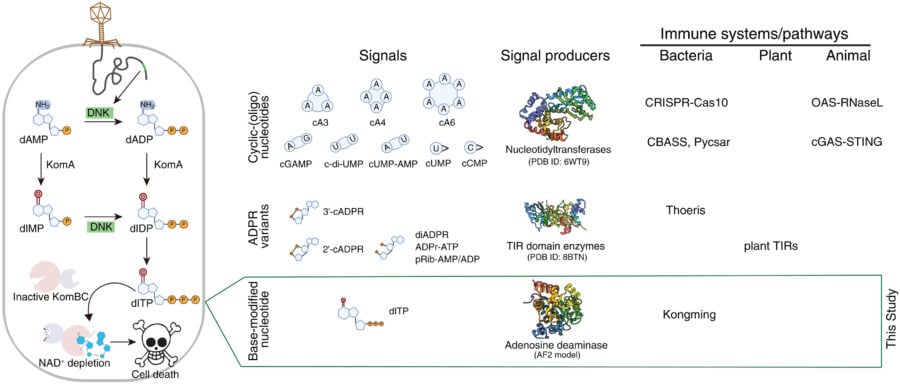Imagine tricking your enemy into giving you their weapons, then using those same weapons to defeat them. That’s exactly what some bacteria do to fight off viral infections, according to groundbreaking research from scientists at the University of Copenhagen and Huazhong Agricultural University.
The newly discovered bacterial defense system, named “Kongming” after an ancient Chinese military strategist famous for similar tactics, reveals an ingenious survival strategy: when viruses attack bacteria, Kongming hijacks the virus’s own replication machinery to trigger a self-destruct mechanism that prevents the infection from spreading.
“We’ve discovered a new antiviral signaling pathway in bacteria that, ironically, relies on a viral enzyme to produce the alarm signal that triggers defense—just like the historical Kongming, who used the production of enemy’s own arrows against them,” explains Assistant Professor Rafael Pinilla-Redondo from the University of Copenhagen, who co-led the study.
Beyond its evolutionary significance, this discovery could have important applications for medicine. As antibiotic resistance continues to grow as a global health threat, researchers are increasingly looking to phage therapy—using viruses that target specific bacteria—as an alternative treatment for bacterial infections.
The research, published in Science, shows how E. coli bacteria transform viral enzymes called nucleotide kinases—which viruses normally use to replicate their genetic material—into tools that instead produce a warning signal molecule called deoxyinosine triphosphate (dITP). This signal activates a cascade that forces the infected bacterium to sacrifice itself, preventing the virus from spreading to neighboring bacteria.
“The bacterium sacrifices itself to stop the virus—which may sound dramatic, but it’s an incredibly effective strategy. By dying, it takes the virus down with it, preventing the infection from spreading to other bacteria in the population. It’s a bit like blowing up a bridge to stop an advancing enemy,” explains Pinilla-Redondo.
In the ongoing evolutionary arms race, some viruses have already developed countermeasures. PhD student Ruiliang Zhao, co-first author of the study, notes that “Some viruses have figured out how to get around Kongming. They carry special enzymes that break down the molecules needed to trigger the system. It’s their way of cutting off the cables of the alarm before it goes off.”
Beyond its evolutionary significance, this discovery could have important applications for medicine. As antibiotic resistance continues to grow as a global health threat, researchers are increasingly looking to phage therapy—using viruses that target specific bacteria—as an alternative treatment for bacterial infections.
Understanding bacterial defense systems like Kongming could help scientists develop more effective phage therapies by revealing how bacteria resist viral attacks and how certain viruses overcome these defenses. Additionally, the molecular machinery driving Kongming may inspire new tools in synthetic biology and diagnostics, potentially even for detecting molecules linked to human diseases like cancer.
This remarkable bacterial strategy not only expands our understanding of microbial immune systems but also provides a vivid reminder that some of nature’s most sophisticated defense mechanisms have evolved in its smallest organisms.
Discover more from SciChi
Subscribe to get the latest posts sent to your email.

